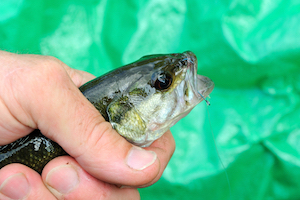Largemouth Bass Reproduction

Most largemouth bass begin spawning as early as year 2 when they weigh as little as 1lb (454 grams).
The spawning season begins in early spring once ice is thawed. The process is dependent on the water temperature being a consistent 60°F/15.5°C to commence.
The ideal temperature for largemouth bass spawning occurs between 65°F and 75°F (18°C to 24°C). A sudden and persistent drop in water temperature below 60°F/15.5C may disrupt spawning and will definitely see a reduced population of fry after hatching. Below 60°F and the male will abandon the nest, reducing the chances of a successful hatching of the eggs and survival of the fry.
In areas with enough food and good habitat such as water plants, largemouths can grow fast.
Largemouth have the same characteristics as other sunfish. They deposit their eggs on the roots of submerged plants or grass over rocky or mud bottoms. The male usually constructs the nest prior to spawning. However sometimes they’ll spawn with very little nest preparation. Water depth over nests ranges from 1 to 8 feet, with the normal depth being 1 1/2 to 3 feet.
The eggs, which may vary from 2,000 to 26,000 in each nest, hatch in 3 to 6 days depending upon water temperature. The warmer the water, the shorter the duration.
- Largemouth bass average 3 to 6 inches in length during the first year. (Lengths of 10 to 12 inches are not unusual in newly stocked lakes and ponds)
- Between 8 and 12 inches in length is expected by the end of the second year
- 16 inches is possible by the end of year 3
Both sexes usually reach sexual maturity in their third year of life, but faster growing bass can mature in the second year.
Largemouth Bass have been known to reach 22 pounds in the southern states, but in Iowa you’ll find they’re smaller.
Spring Bass Fishing
Angling for bass during spring takes a little more effort. The male largemouth bass aren’t going to bite while they’re defending the nest or protecting the fry.
They can be encouraged to take a lure in order to protect the nest from a perceived danger, which appeals to it’s sense of defending it’s territory.
Closed Season
When convincing a male to leave the nest during spawning is very doable, many areas have closed season during spawning. Be sure to check your local fishing ministry or department. Local bait shops and lodges will also know this information.
Conservation
And even in areas where it’s open season it’s better to leave them to spawn in order to ensure good fishing for the future.
With a growing population, we’re putting greater strains on the fishing spots and if we don’t practice conservation more often, fish populations will decline resulting in less fish for us to catch.




Nice.very informative.